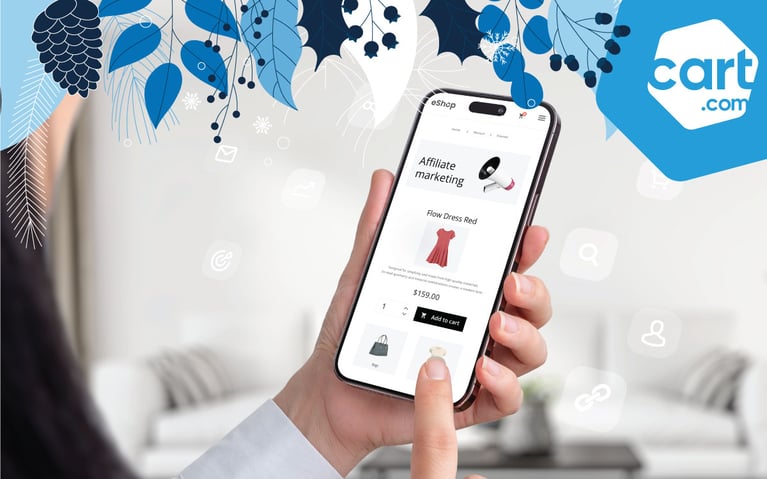During the holiday season, shoppers are ready to buy. And it’s your job as the brand to bring those shoppers to your online store before they shop from your competitors. But how do you ensure site traffic? A tactic known as Holiday SEO. By using Holiday or Seasonal SEO, you can organically gain visibility during the holiday season. And today, we’re sharing how.
Why Holiday SEO Matters
Let's say you sell socks. When a potential buyer searches for “best socks on the market,” you want to make sure your website pops up—and the same goes for holiday SEO. Whether it’s “best socks for dads” or “what to get my sister for Christmas,” if you’ve built enough SEO authority for your site, you’ll see an increase in revenue during the holiday season. Plus, many of these topics are evergreen too, so you create the content once and it produces results each year with minimal maintenance.
When to start implementing Holiday SEO?
SEO does not impact businesses overnight—instead, it’s a slow and rewarding process. That’s why we recommend having a year-round SEO strategy. It can take eight weeks (or more) to index a page—and that’s if it gets indexed at all, creating or updating related content can take time to write and approve, and then you have to monitor your progress and tweak where necessary.
Knowing that, if you’re preparing for Q4, particularly if you have technical optimizations, you should ideally start your holiday SEO in the first quarter of the year. Why? Because consumers are being more intentional about purchases, doing more research, and starting their holiday shopping earlier and earlier. So, if you weren’t planning to start your holiday SEO strategy until the third quarter, it‘s not impossible, however, it will be a bit of a sprint to the finish line.
How does Holiday SEO differ from regular SEO?
 Regular SEO and Holiday SEO both garner authority for your site, however the differences lie in keywords, product choices, and customer expectations during the holiday season. Preparation for the holiday season starts with keyword research and identifying how audiences are searching for your products. From there, you can create a strategy that best serves you and your consumer base.
Regular SEO and Holiday SEO both garner authority for your site, however the differences lie in keywords, product choices, and customer expectations during the holiday season. Preparation for the holiday season starts with keyword research and identifying how audiences are searching for your products. From there, you can create a strategy that best serves you and your consumer base.
Also, it should be noted that your brand may already have holiday pages. If that’s the case, rather than creating new pages every year, plan to use the historically created URLs/pages as they already have tremendous age + SEO value baked into them.
Holiday SEO Tips
Optimize your product pages
When it comes to prepping your Holiday SEO strategy, don’t forget to create compelling product descriptions, use high-quality images, and incorporate holiday-related elements.
Understand the role of content marketing
Plan out blog posts, gift guides, and other engaging content that resonates with the holiday spirit to increase your presence and authority.
Don’t forget the technical side
Implementing the right keywords isn’t enough. Be sure your site speed is optimized, your site is mobile-friendly, and be sure to delete any duplicate content.
Integrate your social media platforms
Share your holiday-related content, engage with your audience and users, and prioritize running holiday-themed campaigns.
Measure your success
Know where you stand and what progress you’ve made by tracking your keyword rankings, monitoring your website traffic, and analyzing conversion rates.
Above all, avoid these things
Neglecting mobile optimization, overusing keywords, and underestimating the powder of user experience.
Cart’s Holiday SEO Checklist
We’re breaking down our Holiday SEO checklist into three easy parts:

Let’s jump in.
Research and Planning
First, we need to create our Holiday List, AKA list out the holidays we want to target. From there, we’ll do holiday keyword research for:
- Products/Categories
- Common questions (question keywords)
- Blog posts (“Best Gifts For [Holiday]” etc.)
We’ll identify keywords that can be associated with any existing page and create new pages for all others. Which brings us to our content plan. That’s where we’ll schedule:
- Existing pages that need updating to target their associated keywords
- New pages to target their associated keywords
We’ll prioritize based on the next holidays, keyword opportunities, and any other business factors.
Creating and Updating SEO Content
Our new and existing pages should target our associated keywords with on-page SEO content like:
- SEO Title (Meta Title)
- H1 (Header 1 - Article Title)
- Subheaders (H2s, H3s, etc)
- Questions & their answers (Question Keywords)
- Internal links to other holiday pages and content
- Structured data
- Breadcrumbs
- Product structured data
- Optional attributes and properties like:
- Shipping
- Price
- Being able to choose the lowest price if there are multiple product options or prices for the product page
Another tip we suggest using is Google Merchant Center’s free listings. This displays results on the search results page outside of the typical SEO results section.
Track and Analyze
 Once you’ve made changes to your Holiday SEO strategy, you’re going to want to check on the fruits of your labor. These are the metrics to consistently track:
Once you’ve made changes to your Holiday SEO strategy, you’re going to want to check on the fruits of your labor. These are the metrics to consistently track:
- Keyword Tracking
-
- Add keywords to your keyword tracker before content associated with those keywords is updated.
- Traffic & Conversion Analysis
-
- Use tracking tools like Google Analytics to track your traffic, conversions and revenue.
- Content Plan Updates & Evergreen Tracking
-
- Keep your content plan up to date and refresh content whenever Keyword, Traffic or Conversion can be improved. Make sure to refresh content to maintain or improve the results and to keep them evergreen.
Subscribe to our emails for the latest industry insights!
By entering your email, you agree to receive marketing emails from Cart.com





